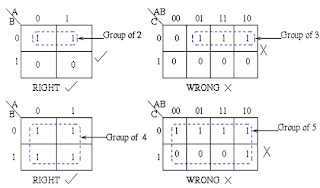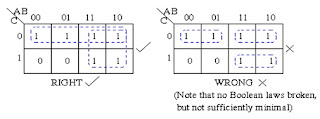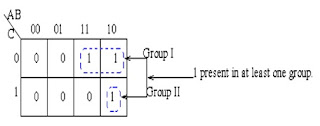The Karnaugh Map reduces the need for extensive calculations by taking advantage of human's pattern-recognition capability.
It also permits the rapid identification and elimination of potential race conditions.
Here's an example of the Karnaugh Map.
The Karnaugh Map also provides a pictorial method of grouping together expressions with common factors and therefore eliminating unwanted variables.
The Karnaugh Map can also be described as a special arrangement of a Truth Table.
The diagram below shows the correspondence between the Karnaugh Map and the Truth Table for the general case of a two variable problem.
The values inside the squares are copied from the output column of the Truth Table , therefore there is one square in the map for every row in the Truth Table.
Around the edge of the Karnaugh Map are the values of the two input variable.
A is along the top and B is down the left hand side.
The diagram below explains this :
The values around the edge of the map can be thought of as coordinates. So an example , the square on the top right hand corner of the map in the above diagram has coordinates A=1 and B=0. This square corresponds to the row in the truth table where A=1 , B=0 and F=1.











Hi, nice description about Karnaugh Map.Thanks for your help..
ReplyDelete-Aparna
Theosoft
yeaa .........its really nice...thnx
ReplyDeletegud stuff, simple and clear
ReplyDeleteyes it's solution is very easy
ReplyDeleteTq
ReplyDeletegreat job
ReplyDeleteGreat
ReplyDeleteTysm
ReplyDeletethank you sir for your help and give depth note about this k-map , don't care condition .
ReplyDeleteGood
ReplyDeleteGreat and that i have a tremendous offer: How Much Remodel House house renovation checklist
ReplyDeleteGreat and I have a keen provide: How To Become A House Renovation best home renovation contractors near me
ReplyDelete